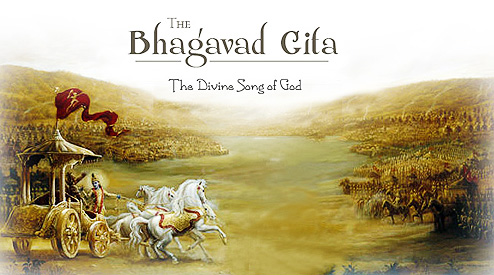
Ved Vyas is also given the honour of being the compiler of the Mahabharata. The Geeta occurs in the Bhishmaparva of the Mahabharata from twenty-third to fortieth chapter. The Geeta begins with the description of both the opposing armies in the war of Kurukshetra with the description of their main heroes. Sanjaya narrates the happenning at the battlefied to the blind king Dhritarashtra, when he is asked to do so. A great hero and the greatest warrior of the Pandava side Arjuna sees members of his family, relatives, and teachers in the battlefield eager to fight from both the warring sides. This causes immense sadness to Arjuna. Overwhelmed by the grief he leaves aside his bow and arrows. The desire for battle dies in his heart and he sits down in the chariot in the state of despondency. Then his charioteer, Lord Krishna preaches him, which is the subject matter of the Geeta.
The Gita is mainly a religious treatise. Though it contains ancient Indian Philosophy, policy and the code of worldly conduct, yet it is essentially a guide to the Hindu way of life. For centuries millions of Hindus have found peace and tranquility in their lives by following the path shown by the Gita. It sets a religious experience of the ultimate reality. The all sects and the followers of all the traditions/doctrines among the Hindus accept the Gita. The Gita can be verily said to be the foundation of not only of the Hindusim, but of the root of the religion itself.
The union (yoga) of the self (atma) with the ultimate reality (paramatma) is the final goal of the followers of the Gita. It brings about a reconciliation among the apparently conflicting doctrines of the way of knowledge (Gyan-Yoga) of action (Karma-Yoga) and of devotion (bhakti-yoga). All these paths lead towards one goal only. The term yoga (means to unite, to yoke), is used in Gita, in the sense of union of the self with the supreme being it is not used in the sense as given in the yoga-sutra of Pantanjali.
Ved Vyas is also given the honour of being the compiler of the Mahabharata. The Geeta occurs in the Bhishmaparva of the Mahabharata from twenty-third to fortieth chapter. The Geeta begins with the description of both the opposing armies in the war of Kurukshetra with the description of their main heroes. Sanjaya narrates the happenning at the battlefied to the blind king Dhritarashtra, when he is asked to do so. A great hero and the greatest warrior of the Pandava side Arjuna sees members of his family, relatives, and teachers in the battlefield eager to fight from both the warring sides. This causes immense sadness to Arjuna. Overwhelmed by the grief he leaves aside his bow and arrows. The desire for battle dies in his heart and he sits down in the chariot in the state of despondency. Then his charioteer, Lord Krishna preaches him, which is the subject matter of the Geeta.
The Gita is mainly a religious treatise. Though it contains ancient Indian Philosophy, policy and the code of worldly conduct, yet it is essentially a guide to the Hindu way of life. For centuries millions of Hindus have found peace and tranquility in their lives by following the path shown by the Gita. It sets a religious experience of the ultimate reality. The all sects and the followers of all the traditions/doctrines among the Hindus accept the Gita. The Gita can be verily said to be the foundation of not only of the Hindusim, but of the root of the religion itself.
The union (yoga) of the self (atma) with the ultimate reality (paramatma) is the final goal of the followers of the Gita. It brings about a reconciliation among the apparently conflicting doctrines of the way of knowledge (Gyan-Yoga) of action (Karma-Yoga) and of devotion (bhakti-yoga). All these paths lead towards one goal only. The term yoga (means to unite, to yoke), is used in Gita, in the sense of union of the self with the supreme being it is not used in the sense as given in the yoga-sutra of Pantanjali.
